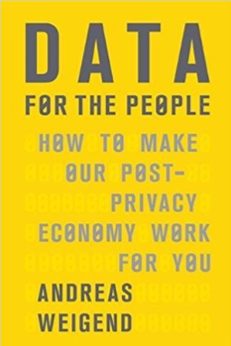Usefulness
Content
Freshness
Do you know what your data is revealing about you? Most of us think we know, but we couldn’t be further from the truth as “Data for the People: How to Make Our Post-Privacy Economy Work for You” points out. In this book, readers will get up close and personal with the data rights we need to fight for and the data responsibilities that business will have to protect in the fast-approaching future of business.

Data has transformed business. With data, businesses can market efficiently, engage on a deeper level with their computers, and deliver products and services faster than ever. Data has also given more power to consumers, allowing unprecedented access to a business with a click. All of this access, however, comes at a risk. Credit card numbers can be stolen, passwords hacked and complete websites taken over by hackers or trolls. Data for the People: How to Make Our Post-Privacy Economy Work for You explores the implications of living in an always-connected and constantly changing,data-filled world.
What is Data for the People About?
For the past hundred years, we’ve cherished privacy, but the time has come to recognize that privacy is now only an illusion.”
– – Data for the People
In order to have information, you have to exchange something. If you want a product delivered to my home, you have to give your address to the store that will deliver it. If yoou want to get hired by a business, you have to provide confidential information (your address, Social Security Number, employment history, etc.) to the HR department or manager.
The majority of people today don’t think twice about doing this.
Data for the People argues that you might need to rethink this approach when it comes to things like social media, artificial intelligence, Big Data and the Internet of Things. Unlike previous generations, relationships in the new age of data are much more complicated. You reveal more about yourself, consciously or unconsciously, in this age than ever before. You aren’t just revealing your address, you’re revealing your interests, passions, habits, and more without even realizing it every time you go to the ATM, click “Like” on Facebook, or order something online.
The outdated idea that if you don’t share, you keep your information private no longer works in a world with Google searches, camera phones, analytics tools and social media. Instead, as author Andreas Weigend advocates, businesses should develop a new model of transparency that lets consumers know what they are gaining in exchange for their information so they can make an informed decision if they want to participate. Weigend argues that, if customers don’t fight for this, they may end up in a world where their data can be used against them rather than for them.
Weigend is a former Chief Scientist for Amazon and currently serves as a professor, consultant, keynote speaker and director of the Social Data Lab. Weigend teaches the popular “Social Data Revolution” course at Stanford University along with other courses at UC Berkely, and around the world.
What Was Best About Data for the People?
Data for the People emphasizes the responsibility businesses and customers share in this new world of data sharing. This is something many businesses fail to discuss at a deep level, despite the constant pressure for more transparency. The book actually breaks down what transparency could look like and how everyone, from the owner of Facebook down to the Facebook user and everyone in between, can be more proactive about protecting their rights to data.
What Could Have Been Done Differently?
Data for the People lays out a new set of data rights for everyone. It also specifically demonstrates how businesses have navigated the confusing world of data rights (like requiring ID for verification and accountability). Data for the People focuses most of its recommendations, from the consumer point of view. More discussion on the impact of data privacy and rights from the point of view of business (like a small business who wants to target customer user’s cell phones for a marketing campaign) would be even more helpful.
Why Read Data for the People?
Data for the People is written for everyone but offers different advice for the two basic groups of people out there, people who provide content (consumers) and people who use the data they provide. For consumers, the book is a call to urge businesses like Facebook or Google to adopt a higher level of transparency and access. For people who use the data (like businesses or government), this book is a rallying call demanding accountability and responsibility. Getting any piece of data from a consumer is risky (and potentially costly), so businesses need to take every precaution they can to keep the data they collect safe from danger while also providing access to the right people. This is a juggling act that businesses will continue to face.
